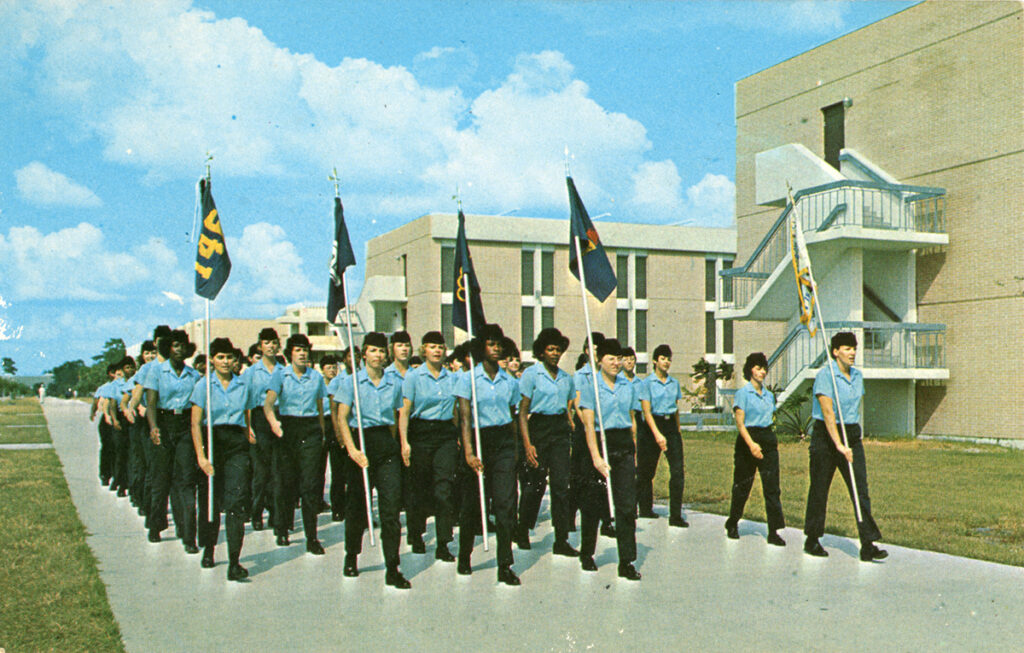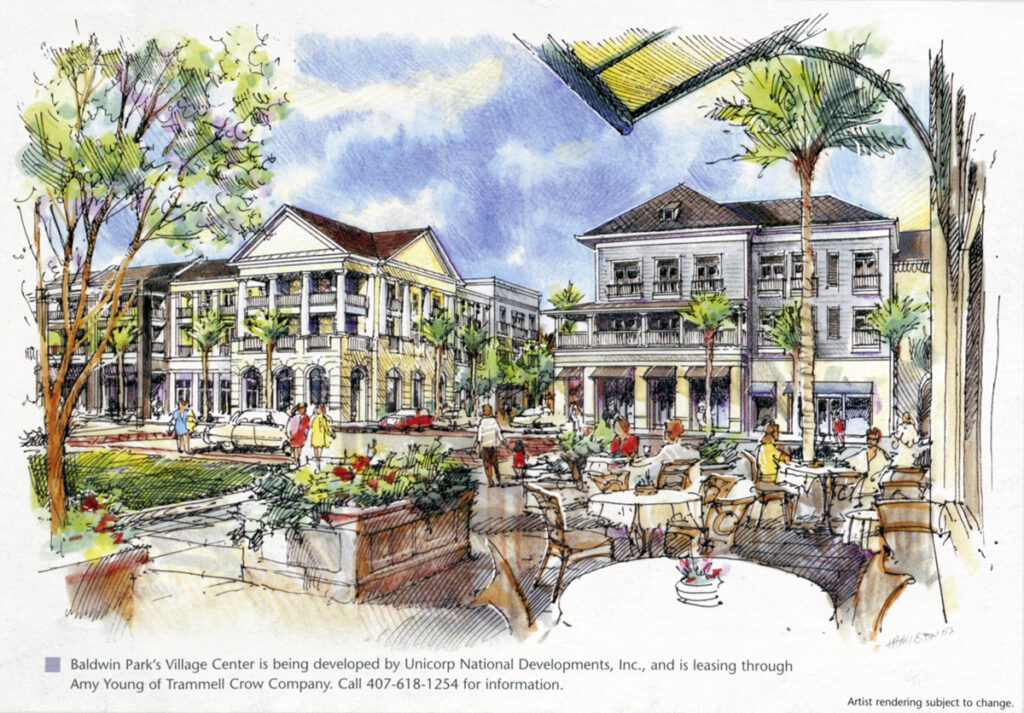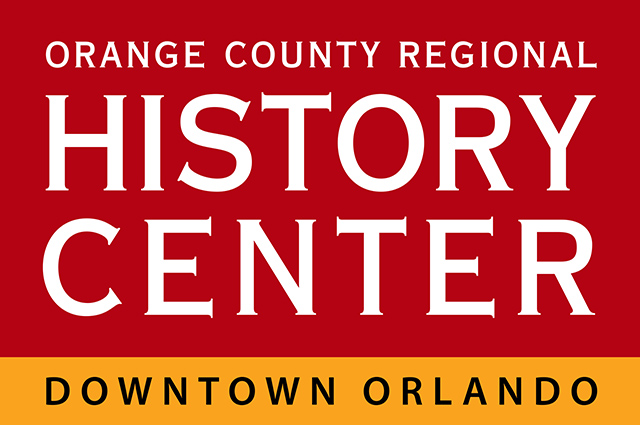By Brendan Bunting O’Connor from the Spring 2025 Edition of Reflections Magazine
Baldwin Park, located just minutes from downtown Orlando, is a vibrant and picturesque community that combines modern living with a deep sense of history, and just a dash of Stepford-like planned-community plastic falseness. One of the things that makes Baldwin Park truly unique is its transformation from a former military installation into a thriving urban neighborhood that city-planning students study in their textbooks.

A 1941 aerial view of buildings at the U.S. Army Air Base in Orlando, now the site of Baldwin Park.
World War II beginnings
The story of Baldwin Park begins with the establishment during World War II of the Orlando Army Air Base, a site that has undergone several transformations over the decades. In 1928 it began as a civilian airfield that soon attracted the attention of U.S. Army Air Corps because of its potential for military applications. With the looming threat of global conflict, the federal government began investing in infrastructure to bolster its air capabilities, and Orlando Municipal Airport was identified as a strategic location for future operations.
In 1940, as tensions in Europe escalated and the United States prepared for potential involvement in World War II, the Army Air Corps formally took control of the Orlando airport. New runways, hangars, and barracks were constructed, transforming the once modest facility into a bustling military installation and Orlando into a bit of a garrison town.
During World War II, Orlando Army Air Base became a critical training hub. It hosted the Army Air Forces School of Applied Tactics, where pilots and aircrews trained in advanced combat techniques. Thousands of troops were stationed at the Orlando base, which by 1942 had grown to 1,000 acres with six runways. It occupied not only the airfield site south of State Road 50 (now Orlando Executive Airport) but also stretched north across the highway to encompass what’s now Baldwin Park.
In 1942, the Orlando area’s military presence further increased with the establishment of a second base, south of the city. Originally called Orlando Air Army Air Field No. 2, the base was renamed Pinecastle Army Air Field on Jan. 1, 1943.
After the war, the Municipal Airport property was returned to the City of Orlando, and the land that would become Audubon Park, Fashion Square Mall, and other properties was sold as the base gradually reduced its operations. In the 1960s, what remained of Orlando’s first Air Force base was turned over to the Navy for use as the country’s third Naval Training Center.

Women U.S. Navy recruits in formation march next to the barracks at Naval Training Center Orlando in the 1970s.
The Navy Years
Commissioned on July 1, 1968, the Naval Training Center Orlando became one of the U.S. Navy’s premier facilities for training recruits and specialized personnel. At its peak, it spanned more than 2,000 acres and featured extensive facilities including classrooms, barracks, administrative buildings, and recreational areas.
The base also played a significant role in the local economy, providing jobs and fostering a sense of community in Orlando. Over three decades, tens of thousands of sailors passed through its gates and called Orlando home.
The end of the Cold War brought significant changes to the U.S. military, including widespread base realignments and closures, and in 1993 the Naval Training Center Orlando was marked for closure.
The decision marked the end of an era for Orlando, as the military had been a prominent fixture in the city for over half a century, going back to the Air Force days.
The closure process was completed in 1999, and the Navy began transferring the land back to the City of Orlando and to private developers. While the closure initially raised concerns about job losses and economic impact, it also presented an opportunity for urban redevelopment. City planners, developers, and community stakeholders began envisioning a new purpose for the land that would honor its history while meeting the needs of a growing population.

Rendering of Baldwin Park’s Village Center from a 2003 development brochure.
A New Urbanist vision
The redevelopment of the former Naval Training Center site was one of the most ambitious urban projects in Orlando’s history. Guided by the principles of New Urbanism, the city aimed to create a walkable, mixed-use community that integrated residential, commercial, and recreational spaces. Unlike most New Urbanist developments such as Celebration or Avalon Park, it wasn’t located in a far-off field or suburb but just two miles from Orlando’s City Hall.
Planning for Baldwin Park began in the late 1990s, with extensive input from urban planners, architects, and the local community. The design brief from City Hall emphasized sustainability, connectivity, and a sense of place.
Construction officially began in 2001, and by 2003, the first residents began moving into Baldwin Park. The transformation was remarkable: a once-sprawling military base was now a thriving neighborhood with tree-lined streets, parks, and vibrant public spaces. The bulk of the hardscape from the Naval Training Center was ground into gravel and used as a porous base for all the green spaces throughout the development, making them into essentially large French ditches, funneling stormwater runoff into the adjacent Lake Baldwin. Baldwin Park is built on the bones of its past.
Today, Baldwin Park is celebrated for its harmonious blend of urban convenience and natural beauty. The community’s design encourages walkability, with wide sidewalks, bike lanes, and interconnected streets. At the neighborhood’s heart is its Village Center, a bustling mixed-use hub of shops, restaurants, and offices. Residents and visitors can enjoy a variety of dining options, boutique stores, and services, all within a short walk from their homes. Baldwin Park even has drag bingo (I know, because
I host it at the local brewery).
The neighborhood’s parks and green spaces are another defining feature. Lake Baldwin Park, which includes a scenic trail and natural green buffer around the lake, is a favorite destination for outdoor enthusiasts. Residents can jog, bike, or simply relax while taking in the tranquil views. The park also includes a dog-friendly area, making it a popular spot for pet owners who live in Baldwin Park and also for those who drive in from surrounding neighborhoods.
Even with all of the shiny new additions, Baldwin Park’s history as a Navy base has not been forgotten. The community’s namesake is Robert Baldwin, undersecretary of the U.S. Navy in the 1960s, and its design incorporates elements that pay homage to its military heritage, with several streets and landmarks named after naval terms and figures.
The transformation of Baldwin Park is now cited as a model for urban redevelopment and infill projects. By prioritizing sustainability, community engagement, and thoughtful design, the project has demonstrated how former industrial or military sites can be successfully repurposed into vibrant neighborhoods. Baldwin Park’s success has inspired similar projects across the country, showcasing the potential for adaptive reuse of land while still honoring its past.

